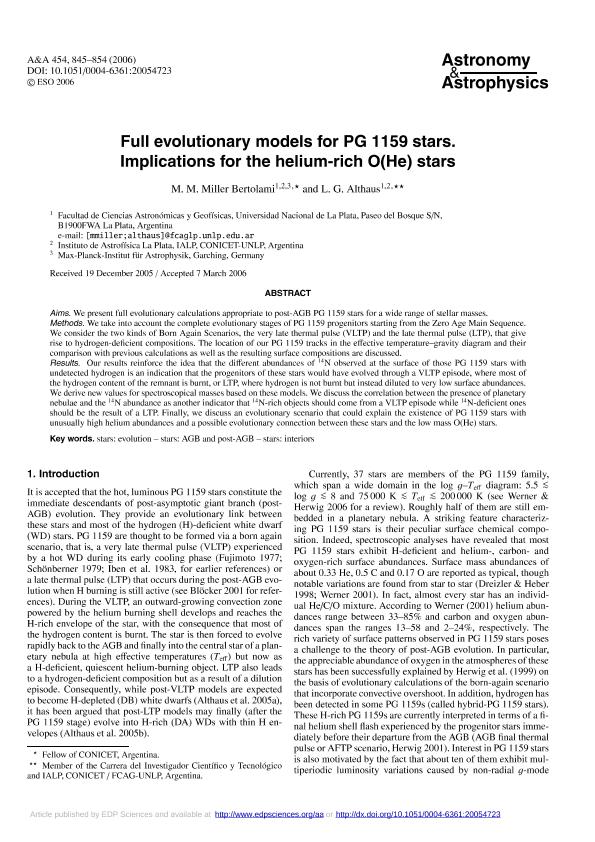Mostrar el registro sencillo del ítem
dc.contributor.author
Miller Bertolami, Marcelo Miguel

dc.contributor.author
Althaus, Leandro Gabriel

dc.date.available
2018-03-19T17:09:01Z
dc.date.issued
2006-08
dc.identifier.citation
Miller Bertolami, Marcelo Miguel; Althaus, Leandro Gabriel; Full evolutionary models for PG 1159 stars. Implications for the helium-rich O(He) stars; EDP Sciences; Astronomy and Astrophysics; 454; 3; 8-2006; 845-854
dc.identifier.issn
0004-6361
dc.identifier.uri
http://hdl.handle.net/11336/39214
dc.description.abstract
Aims. We present full evolutionary calculations appropriate to post-AGB PG 1159 stars for a wide range of stellar masses. Methods. We take into account the complete evolutionary stages of PG 1159 progenitors starting from the Zero Age Main Sequence. We consider the two kinds of Born Again Scenarios, the very late thermal pulse (VLTP) and the late thermal pulse (LTP), that give rise to hydrogen-deficient compositions. The location of our PG 1159 tracks in the effective temperature-gravity diagram and their comparison with previous calculations as well as the resulting surface compositions are discussed. Results. Our results reinforce the idea that the different abundances of 14N observed at the surface of those PG 1159 stars with undetected hydrogen is an indication that the progenitors of these stars would have evolved through a VLTP episode, where most of the hydrogen content of the remnant is burnt, or LTP, where hydrogen is not burnt but instead diluted to very low surface abundances. We derive new values for spectroscopical masses based on these models. We discuss the correlation between the presence of planetary nebulae and the 14N abundance as another indicator that 14N-rich objects should come from a VLTP episode while 14N-deficient ones should be the result of a LTP. Finally, we discuss an evolutionary scenario that could explain the existence of PG 1159 stars with unusually high helium abundances and a possible evolutionary connection between these stars and the low mass O(He) stars. © ESO 2006.
dc.format
application/pdf
dc.language.iso
eng
dc.publisher
EDP Sciences

dc.rights
info:eu-repo/semantics/openAccess
dc.rights.uri
https://creativecommons.org/licenses/by-nc-sa/2.5/ar/
dc.subject
Agb Stars
dc.subject
Post Agb Stars
dc.subject
Interior Stars
dc.subject.classification
Astronomía

dc.subject.classification
Ciencias Físicas

dc.subject.classification
CIENCIAS NATURALES Y EXACTAS

dc.title
Full evolutionary models for PG 1159 stars. Implications for the helium-rich O(He) stars
dc.type
info:eu-repo/semantics/article
dc.type
info:ar-repo/semantics/artículo
dc.type
info:eu-repo/semantics/publishedVersion
dc.date.updated
2018-03-06T15:14:20Z
dc.journal.volume
454
dc.journal.number
3
dc.journal.pagination
845-854
dc.journal.pais
Francia

dc.journal.ciudad
Paris
dc.description.fil
Fil: Miller Bertolami, Marcelo Miguel. Universidad Nacional de La Plata. Facultad de Ciencias Astronómicas y Geofísicas; Argentina. Consejo Nacional de Investigaciones Científicas y Técnicas. Centro Científico Tecnológico Conicet - La Plata. Instituto de Astrofísica La Plata. Universidad Nacional de La Plata. Facultad de Ciencias Astronómicas y Geofísicas. Instituto de Astrofísica La Plata; Argentina
dc.description.fil
Fil: Althaus, Leandro Gabriel. Universidad Nacional de La Plata. Facultad de Ciencias Astronómicas y Geofísicas; Argentina. Consejo Nacional de Investigaciones Científicas y Técnicas. Centro Científico Tecnológico Conicet - La Plata. Instituto de Astrofísica La Plata. Universidad Nacional de La Plata. Facultad de Ciencias Astronómicas y Geofísicas. Instituto de Astrofísica La Plata; Argentina
dc.journal.title
Astronomy and Astrophysics

dc.relation.alternativeid
info:eu-repo/semantics/altIdentifier/doi/http://dx.doi.org/10.1051/0004-6361:20054723
dc.relation.alternativeid
info:eu-repo/semantics/altIdentifier/url/https://www.aanda.org/articles/aa/abs/2006/30/aa4723-05/aa4723-05.html
Archivos asociados
